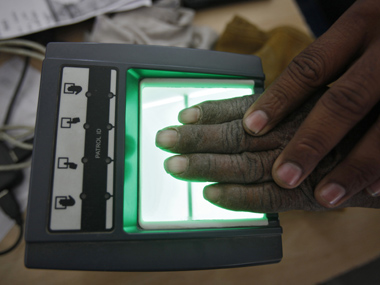The Centre on 26 March notified the new Aadhaar Act, which gives the unique identity number assigned to each Indian citizen statutory backing. The idea of this Act is to empower Aadhaar with legal backing for the purpose of transferring subsidies and government benefits to beneficiaries through designated bank accounts.
The Aadhaar (Targeted Delivery of Financial and other Subsidies, benefits and services) Act, 2016 will provide “efficient, transparent, and targeted delivery of subsidies, benefits and services, the expenditure for which is incurred from the Consolidated Fund of India, to individuals residing in India through assigning of unique identity numbers to such individuals”, said the notification.
It will be used for all benefits linked to the consolidated fund of India. The Aadhaar Bill for this act was approved by Parliament on 16 March and tabled in Parliament as a money Bill, leading to much heated discussion whether this indeed is a money Bill.
A money Bill pertains to taxes or spending or borrowing of the government and requires no approval from the Rajya Sabha. The opposition said the government introduced it as a money Bill only to circumvent the ruling NDA’s minority status in the Rajya Sabha. Finance minister Arun Jaitley, who moved the Bill, countered arguing that it deals with subsidies and money that is flown out of the Consolidated Fund of India and so it indeed is a money Bill.
Whatever the truth is, one thing is for sure: it is the same BJP that had opposed the The National Identification Authority of India Bill when it was introduced in 2010 by the UPA.
So what are the differences between the UPA’s bill and NDA’s Bill?
Here’s a list, as given by Roopal Suhag and Anviti Chaturvedi of PRS Legislative:
Who is entitled for Aadhaar?
As per the new Act, “any person who has resided in India for 182 days (in the one year preceding the application for Aadhaar)”.
The UPA’s Bill said Any person residing in India.
Use of Aadhaar
As per the new Act, in order to verify the identity of a person receiving a subsidy or service, the government may require them to have an Aadhaar number. However, in case a person has applied for an Aadhaar number and not been assigned one, the government will offer an alternative means of identification.
In the UPA’s Bill, no such provision was there.
Further, the new Act says that the number can be used to verify the identity of any person, for any purpose, by any public or private entity.
In the UPA’s Bill, no such provision was there.
The number shall not confer any right of citizenship or domicile to an aadhaar number holder, says the new Act.
The UPA’s bill had a similar provision.
Types of information maintained by the UIDA
The new Act stipulates the identity information to be maintained with UIDA as follows: photograph, biometric information (iris scan and fingerprint), demographic information (name, date of birth, address but excludes race, religion, caste, etc.), and Aadhaar number. The authority may specify any other biological and demographic information to be collected.
The UPA’s Bill had similar provision. However, it did not specify what kinds of biometric information will be maintained and also had no mention of photograph.
When it comes to information on requests for verification of an individual’s identity, the new Act mandates that the identity of the entity requesting for such verification, the time of the request and and the response the entity gets should be maintained.
The UPA’s Bill also had similar provisions, but did not specify what kinds of information related to requests for verification of identity will be covered.
Both the NDA’s Act and UPA’s Bill do not have any clause that requires to collect the purpose for which an individual’s identity is being verified.
Enrolment and authentication for Aadhaar
At the time of enrolment, the individual shall be informed the manner in which the information will be used, the nature of recipients with whom the information will be shared during authentication, and the right to access information.
No such provision in the UPA Bill.
The entity that wants to authenticate identity information of a person has to obtain the consent of the person concerned before collecting his information. Further, it has to ensure that the detail is only submitted to the Central Data Repository for authentication of the individual.
No such provision in the UPA Bill.
The entity has to inform the individual what are the details that may be shared upon authentication, what purposes the details will be used for and also the alternatives to submitting identity information to the requesting entity.
No such provision in the UPA Bill.
UID Authority
The authority shall consist of a Chairperson, two part-time members and a chief executive officer, says the new Act.
This is similar to the UPA’s clause.
As per the new Act, the Chairperson and members of authority shall have experience and knowledge of at least 10 years in matters related to technology, governance, law, etc.
The UPA’s Bill did not specify the time period of experience.
The NDA’s Act stipulates that the revenue collected by the authority shall be credited to the Consolidated Fund of India.
The UPA’s Bill too had a similar clause but also mandated that the entire amount shall be transferred back to the authority.
The new Act does not have any system to analyse the use of Aadhaar numbers.
However, the 2010 Act had put in place a clause to set up an Identity Review Committee to analyse the extent and pattern of usage of Aadhaar numbers across the country.
Restrictions on sharing information
The new Act says biometric information such as an individual’s fingerprints, iris scan and other biological attributes (specified by regulations) will be used only for Aadhaar enrolment and authentication, and for no other purpose. Such information will not be shared with anyone. It will be stored in electronic form and the provisions contained in the Information Technology Act, 2000 shall apply to this information.
No such provision in the UPA’s Bill.
Aadhaar number and information related to an Aadhaar number-holder’s fingerprints and iris scan shall not be published or displayed publicly, except for purposes specified by regulations.
No such provision in the UPA’s Bill.
When authenticating an individual’s identity, the UID authority cannot reveal information related to iris scan and fingerprints to the entity requesting for authentication.
The UPA’s Bill had a similar clause but it also stipulated that UIDA cannot reveal the individual’s demographic information.
The agency requesting authentication of an individual’s identity can use the disclosed information only for purposes for which the individual has given consent.
No such provision in the UPA’s Bill.
When to reveal information
The information of an individual can be revealed in the interest of national security. For this a joint secretary in the central government may issue a direction for revealing the individual’s Aadhaar number, biometric (iris scan, finger print and other biological attributes specified by regulations), demographic information, and photograph. This directive will be valid for 6 months and has to be reviewed by an Oversight Committee with cabinet secretary, secretaries of legal affairs and information technology.
The UPA’s Bill too had a similar clause, except that there was no requirement for an Oversight Committee. Also, there was no validity period specified.
Secondly, on the order of a district judge or a higher court, an individual’s Aadhaar number, photograph, and demographic information, may be revealed.
The UPA’s Bill had a similar clause.
Offences and penalties
As per the new Act, a person shall be punished with imprisonment for up to three years and slapped a fine not less than Rs 10 lakh if he/she gains unauthorised access to the Central Identities Data Repository or reveal any information stored in the repository.
The UPA Bill had a similar provision, but the fine was a higher Rs 1 crore.
If a requesting entity uses the details for any purpose other than authentication, and an enrolling agency fails to comply with its rules, they shall be punishable with imprisonment extendable to three years or a fine up to Rs 1 lakh (in case of a company) or both.
No such provision in the UPA’s Bill.
The new Act also says if an offence is committed for which no penalty is specified, the person concerned shall be punished with imprisonment up to one year or fine up to Rs 25,000 or Rs 1 lakh (in case of a company) or both.
The UPA’s Bill had a similar clause but the imprisonment was up to three years.
No court shall take cognisance of any offence except on a complaint made by the UIDA, says the new Act.
The 2010 bill had a similar clause.
With inputs from PTI


)




)
)
)
)
)
)
)
)